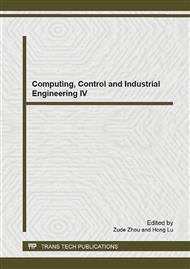[1]
W. A. Kline, R. E. DeVor, I. A. Shareef, The prediction of surface accuracy in end Milling, ASME, Journal of Engineering Industry, 104 (1982) 272–278.
DOI: 10.1115/1.3185830
Google Scholar
[2]
W. A. Kline, R. E. DeVor, The effect of runout on cutting geometry and forces in end milling, International Journal of Machine Tool Design and Research 23(1983)123–140.
DOI: 10.1016/0020-7357(83)90012-4
Google Scholar
[3]
J. W. Sutherland, R. E. DeVor, An improved method for cutting force and surface error prediction in flexible end milling systems, ASME Journal of Engineering for Industry108(1986)269–279.
DOI: 10.1115/1.3187077
Google Scholar
[4]
J.W. Sutherland, T.S. Babin The geometry of surface generated by the bottom of an end mill Proc. 16th North Am. Manuf. Res. Conf. (1988), p.202–208.
Google Scholar
[5]
F. Ismail, M. A. Elbestawi, R. Du, K. Urbasik, Generation of milled surfaces including tool dynamics and wear, ASME Journal of Engineering for Industry, 115 (1993) 245–252.
DOI: 10.1115/1.2901656
Google Scholar
[6]
M.A. Elbestawi, F. Ismail, K.M. Yuen, Surface topography characterization in finish milling, International Journal of Machine Tools & Manufacture, 34 (1994) 245–255.
DOI: 10.1016/0890-6955(94)90104-x
Google Scholar
[7]
S. Ranganath, J. W. Sutherland, An improved method for cutter runout modeling in the peripheral milling process, Machining Science and Technology 6(1) (2002)1–20.
DOI: 10.1081/mst-120003182
Google Scholar
[8]
S. H. Ryu, D. K. Choi, C. N. Chu, Roughness and texture generation on end milled surfaces, International Journal of Machine Tools & Manufacture 46 (2006) 404–412.
DOI: 10.1016/j.ijmachtools.2005.05.010
Google Scholar
[9]
M. B. G. Jun, K. Bourne, R. E. DeVor, S .G. Kapoor, Estimation of effective error parameters in high-speed micro-end milling, International Journal of Machine Tools & Manufacture 47 (2007) 1449–1454.
DOI: 10.1016/j.ijmachtools.2006.09.027
Google Scholar
[10]
O. E. E. K. Omar, T. El-Wardany, E. Ng, M. A. Elbestawi, An improved cutting force and surface topography prediction model in end milling, International Journal of Machine Tools and Manufacture, 47 (7-8) (2007)1263-1275.
DOI: 10.1016/j.ijmachtools.2006.08.021
Google Scholar
[11]
B. Denkena, M. Krüger, D. Bachrathy, G. Stepan, Model based reconstruction of milled surface topography from measured cutting forces, International Journal of Machine Tools and Manufacture, 54-55(2012) 25-33.
DOI: 10.1016/j.ijmachtools.2011.12.007
Google Scholar


